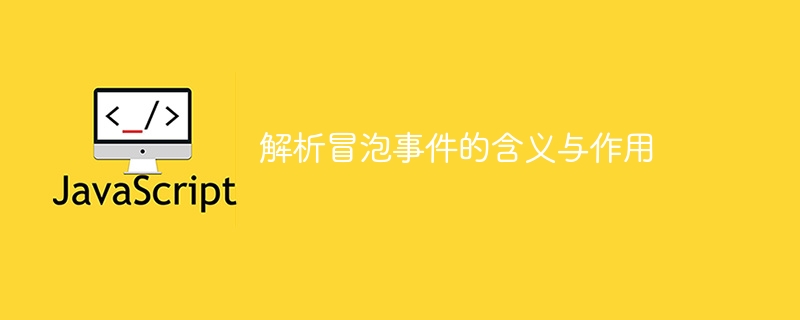Home >Web Front-end >JS Tutorial >Analyze the meaning and function of bubbling events
Analyze the meaning and function of bubbling events
- 王林Original
- 2024-01-13 15:27:06800browse

Analysis of the meaning and function of bubbling events
Bubble events refer to when a certain event occurs on an element in a web page, the event will occur upward one by one It is passed down through its parent elements until it reaches the top-level element. The function of bubbling events is to allow multiple elements to respond to the same event at the same time, achieving unified management and processing of events. In this article, we'll dive into what bubbling events are and do, and provide concrete code examples.
1. The meaning of bubbling events
Bubbing events mean that when a certain event occurs on an element, the event will be passed up to the parent element step by step until it is passed to the final element. Top elements. The meaning of a bubbling event is that it simulates the event delivery mechanism so that multiple elements can respond to the same event at the same time.
For example, when we click on a button, the click event of the button will be triggered. But in a web page, a button may be contained within a container element, and the container element may be contained within another higher-level element. If the bubbling event is enabled, the button's click event will be passed up to the container element, and then to the higher-level element. In this way, we can uniformly manage and process click events on elements at different levels without having to write separate event handling functions for each element.
2. The role of bubbling events
- Unified management and processing of events: Bubble events allow multiple elements to share the same event handling function. When an event is triggered, we only need to bind the event handling function to the top-level element, and the same event on all child elements will be passed to this function. In this way, we can simplify the code and improve the maintainability of the code.
- Dynamic addition and deletion of events: Through bubbling events, we can dynamically add or delete events at runtime. For example, when we add a new child element dynamically, it inherits the events of the parent element and can respond to the same events. If we delete an element, the events it was previously bound to will also be deleted.
3. Code Example
The following is a specific code example, showing how to use bubbling events:
HTML code:
<div id="container"> <button id="btn1">按钮1</button> <button id="btn2">按钮2</button> <button id="btn3">按钮3</button> </div>
JavaScript code:
// 获取父元素
var container = document.getElementById('container');
// 绑定冒泡事件处理函数
container.addEventListener('click', function(event) {
// 获取触发事件的元素
var target = event.target;
// 根据不同的触发元素执行不同的逻辑
switch(target.id) {
case 'btn1':
console.log('按钮1被点击');
break;
case 'btn2':
console.log('按钮2被点击');
break;
case 'btn3':
console.log('按钮3被点击');
break;
default:
console.log('其他元素被点击');
}
});In the above code, we first obtain the parent element container through the getElementById method. Then use the addEventListener method to bind the click event handler function. When the child element button is clicked, the click event will bubble up and be passed to the parent element container, eventually triggering the event handler on the parent element. In this function, we execute different logic based on different trigger elements to implement event processing and management.
Through this example, we can see the role and advantages of bubbling events. It can simplify the code, improve the maintainability of the code, and can also dynamically add and delete events. Therefore, in the process of writing web pages, we should give full play to the role of bubbling events and make reasonable use of them to improve development efficiency and code quality.
The above is the detailed content of Analyze the meaning and function of bubbling events. For more information, please follow other related articles on the PHP Chinese website!

